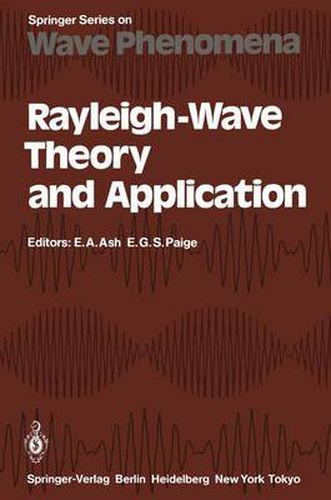Readings Newsletter
Become a Readings Member to make your shopping experience even easier.
Sign in or sign up for free!
You’re not far away from qualifying for FREE standard shipping within Australia
You’ve qualified for FREE standard shipping within Australia
The cart is loading…






This title is printed to order. This book may have been self-published. If so, we cannot guarantee the quality of the content. In the main most books will have gone through the editing process however some may not. We therefore suggest that you be aware of this before ordering this book. If in doubt check either the author or publisher’s details as we are unable to accept any returns unless they are faulty. Please contact us if you have any questions.
There is no respect for mere age in Science or Technology. Yet the cen tenary of the discovery, by the third Lord Rayleigh, that elastic waves can be guided by a surface, is memorable for the contradictions which it encompasses: Rayleigh’s assessment of his classic 1885 paper as a rather minor mathematical development with a potential value only in seismology on the one hand; on the other the rediscovery of the subject in a totally that of electronic signal processing - which has led to its different fiel- explosive growth over the last twenty years. The new surface acoustic wave (SAW) devices have proved to be per electronic components. Today almost all television receivers con vasive tain one or more SAW filters, sophisticated radars depend on SAW signal processing, and SAW devices have been incorporated in ultra-high perfor mance opto-electronic systems. With the objective of surveying these developments and attempting to predict those that can be foreseen, as well as marking the centenary of Lord Rayleigh’s discovery, The Rank Prize Funds’ Committee for Opto Electronics organised a symposium in London, in July 1985. It was held in the Royal Institution, London, where Rayleigh himself once worked and often lectured. The present volume is the tangible outcome of the symposium, In which international experts survey.ed their various fields, and presented the most exciting recent developments.
$9.00 standard shipping within Australia
FREE standard shipping within Australia for orders over $100.00
Express & International shipping calculated at checkout
This title is printed to order. This book may have been self-published. If so, we cannot guarantee the quality of the content. In the main most books will have gone through the editing process however some may not. We therefore suggest that you be aware of this before ordering this book. If in doubt check either the author or publisher’s details as we are unable to accept any returns unless they are faulty. Please contact us if you have any questions.
There is no respect for mere age in Science or Technology. Yet the cen tenary of the discovery, by the third Lord Rayleigh, that elastic waves can be guided by a surface, is memorable for the contradictions which it encompasses: Rayleigh’s assessment of his classic 1885 paper as a rather minor mathematical development with a potential value only in seismology on the one hand; on the other the rediscovery of the subject in a totally that of electronic signal processing - which has led to its different fiel- explosive growth over the last twenty years. The new surface acoustic wave (SAW) devices have proved to be per electronic components. Today almost all television receivers con vasive tain one or more SAW filters, sophisticated radars depend on SAW signal processing, and SAW devices have been incorporated in ultra-high perfor mance opto-electronic systems. With the objective of surveying these developments and attempting to predict those that can be foreseen, as well as marking the centenary of Lord Rayleigh’s discovery, The Rank Prize Funds’ Committee for Opto Electronics organised a symposium in London, in July 1985. It was held in the Royal Institution, London, where Rayleigh himself once worked and often lectured. The present volume is the tangible outcome of the symposium, In which international experts survey.ed their various fields, and presented the most exciting recent developments.